A Study on Energy-Saving Technologies Optimization towards Nearly Zero Energy Educational Buildings in Four Major Climatic Regions of China
Abstract
1. Introduction
2. Methodology
2.1. Case Study
2.1.1. Building Description
2.1.2. Model Development and Verification
2.1.3. Base Models in Four Cities
2.2. Evaluation Index and Weight Calculation Method
3. Analysis and Results
3.1. Passive Energy-Saving Technologies
3.1.1. High-Performance Envelope
3.1.2. Shading
3.1.3. Natural Ventilation
3.2. Active Energy-Saving Technologies
3.2.1. Lighting Control Strategy
3.2.2. Air-to-Air Heat Recovery Technology
3.3. Renewable Energy
3.4. Establishment of the Recommended Technology Selection Systems
- (1)
- SC region: Air-to-air heat recovery > GSHP > High-performance envelope > Lighting control > Natural ventilation > Shading.
- (2)
- CC region: Air-to-air heat recovery > GSHP > Lighting control > High-performance envelope > Natural ventilation > Shading.
- (3)
- HS/CW region: Air-to-air heat recovery > Lighting control > Natural ventilation > GSHP > Shading > High-performance envelope.
- (4)
- HS/WW region: Air-to-air heat recovery > Natural ventilation > Lighting control > GSHP > Shading > High-performance envelope.
4. Discussion
5. Conclusions
- (1)
- SC region: Air-to-air heat recovery > GSHP > High-performance envelope > Lighting control > Natural ventilation > Shading.
- (2)
- CC region: Air-to-air heat recovery > GSHP > Lighting control > High-performance envelope > Natural ventilation > Shading.
- (3)
- HS/CW region: Air-to-air heat recovery > Lighting control > Natural ventilation > GSHP > Shading > High-performance envelope.
- (4)
- HS/WW region: Air-to-air heat recovery > Natural ventilation > Lighting control > GSHP > Shading > High-performance envelope.
Author Contributions
Funding
Conflicts of Interest
Abbreviations
| EPBD | energy performance of buildings directive |
| nZEB | nearly zero energy building |
| PV | photovoltaic |
| nZEEB | nearly zero energy educational building |
| GSHP | ground source heat pump |
| WWR | window to wall ratio |
| Low-E | low emissivity |
| SC | severe cold |
| CC | cold climate |
| HS/CW | hot summer and cold winter |
| HS/WW | hot summer and warm winter |
| MC | mild climate |
| PMV | predicted mean vote |
| HVAC | heating, ventilation and air conditioning |
| ECR | energy-saving contribution rate |
| S/V | surface to volume |
| EPS | expanded polystyrene board |
| NMBE | normalized mean bias error |
| CVRMSE | root mean square error |
| DB | DesignBuilder |
| U-value | heat transfer coefficient |
| SHGC | solar heat gain coefficient |
| COP | coefficient of performance |
| SCOP | system performance coefficient |
| SEER | system energy efficiency ratio |
| PPD | predicted percentage dissatisfied |
| ASHP | air source heat pump |
References
- Crawley, D.; Pless, S.; Torcellini, P. Getting to net zero. ASHRAE 2009, 51, 18–25. [Google Scholar]
- Aste, N.; Adhikari, R.S.; Del Pero, C. Photovoltaic technology for renewable electricity production: Towards net zero energy buildings. In Proceedings of the International Conference on Clean Electrical Power (ICCEP), Ischia, Italy, 14–16 June 2011. [Google Scholar]
- China Building Efficiency Research Centre, Tsinghua University. Annual Report on China Building Energy Efficiency; China Architecture and Building Press: Beijing, China, 2008. [Google Scholar]
- DOE. Saving Energy and Money with Building Energy Codes in the United States. Available online: https://www.energycodes.gov/sites/default/files/documents/CodesFactSheet_12-28-16.pdf (accessed on 1 January 2016).
- Yang, X.Y.; Zhang, S.C.; Xu, W. Impact of zero energy buildings on medium-to-long term building energy consumption in China. Energy Pol. 2019, 129, 574–586. [Google Scholar] [CrossRef]
- EU Directive. 2010/31/EU of the European Parliament and of the Council of 19 May 2010 on the energy performance of buildings (recast). Off. J. Eur. Union 2010, 18, 13–35. [Google Scholar]
- Swedish Government Bill 2005/06:145, National Program for Energy Efficiency and Energy-Smart Construction. Available online: http://www.government.se/information-material/2006/05/national-programme-for-energy-efficiencyand-energy-smart-construction/ (accessed on 20 April 2009).
- Mlecnik, E. Defining nearly zero-energy housing in Belgium and The Netherlands. Energy Effic. 2012, 5, 411–431. [Google Scholar] [CrossRef]
- Deng, S.; Wang, R.Z.; Dai, Y.J. How to evaluate performance of net zero energy building—A literature research. Energy 2014, 71, 1–16. [Google Scholar] [CrossRef]
- European Commission. Energy Performance of Building Directive; European Commission: Brussels, Belgium, 2010. [Google Scholar]
- Li, D.H.W.; Liu, Y.; Lam, J.C. Zero energy buildings and sustainable development implications—A review. Energy 2013, 54, 1–10. [Google Scholar] [CrossRef]
- Attia, S.; Eleftheriou, P.; Xeni, F.; Morlot, R.; Ménézo, C.; Kostopoulos, V.; Betsi, M.; Kalaitzoglou, I.; Pagliano, L.; Cellura, M.; et al. Overview and future challenges of nearly zero energy buildings (nZEB) design in Southern Europe. Energy Build. 2017, 155, 439–458. [Google Scholar] [CrossRef]
- Ascione, F.; De Masi, R.F.; de Rossi, F.; Ruggiero, S.; Vanoli, G.P. Optimization of building envelope design for nZEBs in Mediterranean climate: Performance analysis of residential case study. Appl. Energy 2016, 183, 938–957. [Google Scholar] [CrossRef]
- Wang, Z.X.; Zhao, J. Optimization of passive envelop energy efficient measures for office buildings in different climate regions of China based on modified sensitivity analysis. Sustainabilty 2018, 10, 907. [Google Scholar] [CrossRef]
- Touloupaki, E.; Theodosiou, T. Optimization of external envelope insulation thickness: A parametric study. Energies 2017, 10, 3. [Google Scholar] [CrossRef]
- Sun, Y.Y.; Wilson, R.B.; Wu, Y.P. A Review of Transparent Insulation Material (TIM) for building energy saving and daylight comfort. Appl. Energy 2018, 226, 713–729. [Google Scholar] [CrossRef]
- Alam, M.J.; Islam, M.A. Effect of external shading and window glazing on energy consumption of buildings in Bangladesh. Advan. Build. Energy Res. 2017, 11, 180–192. [Google Scholar] [CrossRef]
- Hassouneh, K.; Alshboul, A.; Al-Salaymeh, A. Influence of windows on the energy balance of apartment buildings in Amman. Energy Conv. Manag. 2010, 51, 1583–1591. [Google Scholar] [CrossRef]
- Kirimtat, A.; Koyunbaba, B.K.; Chatzikonstantinou, I.; Sariyildiz, S. Review of simulation modeling for shading devices in buildings. Renew. Sustain. Energy Rev. 2016, 53, 23–49. [Google Scholar] [CrossRef]
- Jiang, Y. Ultra-Low Energy Consumption Building Technology and Application; China Building Industry Press: Beijing, China, 2005. [Google Scholar]
- Palmero-Marrero, A.I.; Oliveira, A.C. Effect of louver shading devices on building energy requirements. Appl. Energy 2010, 87, 2040–2049. [Google Scholar] [CrossRef]
- Liu, S.; Kwok, Y.T.; Lau, K.K.L.; Chan, P.W.; Ng, E. Investigating the energy saving potential of applying shading panels on opaque façades: A case study for residential buildings in Hong Kong. Energy Build. 2019, 195, 78–91. [Google Scholar] [CrossRef]
- Gago, E.J.; Muneer, T.; Knez, M.; Köster, H. Natural light controls and guides in buildings. Energy saving for electrical lighting, reduction of cooling load. Renew. Sustain. Energy Rev. 2015, 41, 1–13. [Google Scholar] [CrossRef]
- Boyano, A.; Hernandez, P.; Wolf, O. Energy demands and potential savings in European office buildings: Case studies based on EnergyPlus simulations. Energy Build. 2013, 65, 19–28. [Google Scholar] [CrossRef]
- El Fouih, Y.; Stabat, P.; Rivière, P.; Hoang, P.; Archambault, V. Adequacy of air-to-air heat recovery ventilation system applied in low energy buildings. Energy Build. 2012, 54, 29–39. [Google Scholar] [CrossRef]
- Roulet, C.A.; Heidt, F.D.; Foradini, F.; Pibiri, M.-C. Real heat recovery with air handling units. Energy Build. 2001, 33, 495–502. [Google Scholar] [CrossRef]
- Orme, M. Estimates of the energy impact of ventilation and associated financial expenditures. Energy Build. 2001, 33, 199–205. [Google Scholar] [CrossRef]
- Liddament, M.W.; Orme, M. Energy and ventilation. Appl. Therm. Eng. 1998, 18, 1101–1109. [Google Scholar] [CrossRef]
- Simonson, C. Energy consumption and ventilation performance of a naturally ventilated ecological house in a cold climate. Energy Build. 2005, 37, 23–35. [Google Scholar] [CrossRef]
- Zhong, K.; Kang, Y.M. Applicability of air-to-air heat recovery ventilators in China. Appl. Therm. Eng. 2009, 29, 830–840. [Google Scholar] [CrossRef]
- Kang, Y.M.; Wang, Y.J.; Zhong, K.; Liu, J.P. Temperature ranges of the application of air-to-air heat recovery ventilator in supermarkets in winter, China. Energy Build. 2010, 42, 2289–2295. [Google Scholar] [CrossRef]
- Dell’Osso, G.R.; Iannone, F.; Pierucci, A.; Rinaldi, A. Control strategies of the natural ventilation for passive cooling for an existing residential building in Mediterranean climate. In Proceedings of the 36th AIVC-5th TightVent-3rd Venticool Conference, Madrid, Spain, 23–24 September 2015; pp. 396–405. [Google Scholar]
- Liu, Z.J.; Liu, Y.W.; He, B.J.; Xu, W.; Jin, G.Y.; Zhang, X.T. Application and suitability analysis of the key technologies in nearly zero energy buildings in China. Renew. Sustain. Energy Rev. 2019, 101, 329–345. [Google Scholar] [CrossRef]
- Zhou, Z.H.; Feng, L.; Zhang, S.Z.; Wang, C.D.; Chen, G.Y.; Du, T.; Li, Y.S.; Zuo, J. The operational performance of “net zero energy building”: A study in China. Appl. Energy 2016, 177, 716–728. [Google Scholar] [CrossRef]
- Wilberforce, T.; Baroutaji, A.; El Hassan, Z.; Thompson, J.; Soudan, B.; Olabi, A.G. Prospects and challenges of concentrated solar photovoltaics and enhanced geothermal energy technologies. Sci. Total Env. 2018, 659, 851–961. [Google Scholar] [CrossRef]
- Good, C.; Andresen, I.; Hestnes, A.G. Solar energy for net zero energy buildings—A comparison between solar thermal, PV and photovoltaic–thermal (PV/T) systems. Sol. Energy 2015, 122, 986–996. [Google Scholar] [CrossRef]
- Wu, W.; Skye, H.M. Net-zero nation: HVAC and PV systems for residential net-zero energy buildings across the United States. Energy Convers. Manag. 2018, 177, 605–628. [Google Scholar] [CrossRef]
- Ascione, F.; D’Agostino, D.; Marino, C.; Minichiello, F. Earth-to-air heat exchanger for NZEB in Mediterranean climate. Renew. Energy 2016, 99, 553–563. [Google Scholar] [CrossRef]
- Raji, B.; Tenpierik, M.J.; van den Dobbelsteen, A. An assessment of energy-saving solutions for the envelope design of high-rise buildings in temperate climates: A case study in The Netherlands. Energy Build. 2016, 124, 210–221. [Google Scholar] [CrossRef]
- Pikas, E.; Thalfeldt, M.; Kurnitski, J. Cost optimal and nearly zero energy building solutions for office buildings. Energy Build. 2014, 74, 30–42. [Google Scholar] [CrossRef]
- Rey-Hernandez, J.M.; Velasco-Gomez, E.; San Jose-Alonso, J.F.; Tejero-Gonzalez, A.; Gonzalez-Gonzalez, S.L.; Rey-Martinez, F.J. Monitoring data study of the performance of renewable energy systems in a near zero energy building in Spain: A case study. Energies 2018, 11, 2979. [Google Scholar] [CrossRef]
- Rey-Hernandez, J.M.; Velasco-Gomez, E.; San Jose-Alonso, J.E.; Tejero-Gonzalez, A.; Rey-Martinez, F.J. Energy analysis at a near zero energy building, a case-study in Spain. Energies 2018, 11, 857. [Google Scholar] [CrossRef]
- Fernández Hernández, F.; Cejudo López, J.M.; Peña Suárez, J.M.; González Muriano, M.C.; Carrillo Rueda, S. Effects of louvers shading devices on visual comfort and energy demand of an office building. A case of study. Energy Procedia 2017, 140, 207–216. [Google Scholar] [CrossRef]
- Goia, F. Search for the optimal window-to-wall ratio in office buildings in different European climates and the implications on total energy saving potential. Sol. Energy 2016, 132, 467–492. [Google Scholar] [CrossRef]
- Rahman, M.M.; Rasul, M.G.; Khan, M.M.K. Energy conservation measures in an institutional building in sub-tropical climate in Australia. Appl. Energy 2010, 87, 2994–3004. [Google Scholar] [CrossRef]
- Irulegi, O.; Ruiz-Pardo, A.; Serra, A.; Salmeron, J.M.; Vega, R. Retrofit strategies towards Net Zero Energy Educational Buildings: A case study at the University of the Basque Country. Energy Build. 2017, 144, 387–400. [Google Scholar] [CrossRef]
- Freewan, A.A.Y. Impact of external shading devices on thermal and daylighting performance of offices in hot climate regions. Sol. Energy 2014, 102, 14–30. [Google Scholar] [CrossRef]
- Al-Masrani, S.M.; Al-Obaidi, K.M.; Zalin, N.A.; Isma, M.I.A. Design optimisation of solar shading systems for tropical office buildings: Challenges and future trends. Sol. Energy 2018, 170, 849–872. [Google Scholar] [CrossRef]
- Kamal, R.; Moloney, F.; Wickramaratne, C.; Narasimhan, A.; Goswami, D.Y. Strategic control and cost optimization of thermal energy storage in buildings using EnergyPlus. Appl. Energy 2019, 246, 77–90. [Google Scholar] [CrossRef]
- IPMVP. Concepts and Options for Determining Energy and Water Savings; International Performance Measurement & Verification Protocol Committee: Washington, DC, USA, 2002. [Google Scholar]
- Cetin, K.S.; Fathollahzadeh, M.H.; Kunwar, N.; Do, H.; Tabares-Velasco, P.C. Development and validation of an HVAC on/off controller in EnergyPlus for energy simulation of residential and small commercial buildings. Energy Build. 2019, 183, 467–483. [Google Scholar] [CrossRef]
- ASHRAE. Measurement of Energy and Demand Savings; ASHRAE Guideline 14-2014; American Society of Heating, Refrigerating and Air-Conditioning Engineers Inc.: Atlanta, GA, USA, 2014. [Google Scholar]
- Ministry of Housing and Urban-Rural Development of the People’s Republic of China (MOHURD). Design Standard for Energy Efficiency of Public Buildings (GB50189-2015); China Building Industry Press: Beijing, China, 2015.
- Ministry of Housing and Urban-Rural Development of the People’s Republic of China (MOHURD). Design Code for Heating Ventilation and Air Conditioning of Civil Buildings (GB 50736—2012); China Standard Press: Beijing, China, 2012.
- Ministry of Housing and Urban-Rural Development of the People’s Republic of China (MOHURD). Evaluation Standard for Application of Renewable Energy in Buildings (GB/T 50801-2013); China Standard Press: Beijing, China, 2012.
- Huang, L.; Song, B.; Deng, Q.Q.; Zheng, R.Y. Performance simulation and economic analysis of solar air conditioning system in hot summer and cold winter areas. Sol. Energy 2019, 1, 71–76. [Google Scholar]
- Eicker, U.; Pietruschka, D. Design and performance of solar powered absorption cooling system in office buildings. Energy Build. 2009, 41, 81–91. [Google Scholar] [CrossRef]
- Xu, W.; Sun, D.Y.; Lu, F.; Yu, Z.Y.; Wang, J. Research progress and reflection on the definition and technical index system of nearly zero-energy. Build. Sci. 2018, 34, 1–9. [Google Scholar]
- Sun, P.C.; Wu, J.S.; Ge, X.; Wang, Y. Research on net zero energy building energy consumption index system. Constr. Sci. Technol. 2019, 18, 31–34. [Google Scholar] [CrossRef]
- Liu, Y.; Lam, J.C.; Tsang, C.L. Energy performance of building envelopes in different climate zones in China. Appl. Energy 2008, 85, 800–817. [Google Scholar]
- Ministry of Housing and Urban-Rural Development of the People’s Republic of China (MOHURD). Technical Guidelines for Passive Ultra-Low-Energy Green Buildings (Trial) (Residential Buildings); Ministry of Housing and Urban-Rural Development: Beijing, China, 2015.
- Murray, M.; Robin, L.; Andrew, B.; Yasmin, B. Climate Consultant 4.0 Develops Design Guidelines for Each Unique Climate; American Solar Energy Society: Buffalo, NY, USA. Available online: http://www.energy-design-tools.aud.ucla.edu/papers/ASES09-Milne.pdf (accessed on 20 May 2009).
- Zhao, L.J. Analysis on College Building Design Strategies in Cold Northern Regions from the Perspective of Low Energy Consumption; Dalian University of Technology: Dalian, China, 2016. [Google Scholar]
- Sun, S. Research on the Design Strategy of the Office Buildings in the Cold Area Zero Energy Consumption; Hebei University of Technology: Hongqiao, China, 2017. [Google Scholar]
- Rinaldi, A.; Roccotelli, M.; Mangini, A.M.; Fanti, M.P.; Iannone, F. Natural ventilation for passive cooling by means of optimized control logics. Procedia Eng. 2017, 180, 841–850. [Google Scholar] [CrossRef]
- Ministry of Housing and Urban-Rural Development of the People’s Republic of China (MOHURD). Code for Design of Heating Ventilation and Air Conditioning (GB 50019—2003); China Standard Press: Beijing, China, 2003.
- Li, H.L. Analysis and Optimization of Indoor Light Environment in Typical Space of Universities; Qingdao University of Technology: Qingdao, China, 2018. [Google Scholar]
- Ministry of Housing and Urban-Rural Development of the People’s Republic of China (MOHURD). Standard for Daylighting Design of Building (GB 50033-2013); China Standard Press: Beijing, China, 2012.
- Dieckmanu, J.; Roth, K.W.; Brodrick, J. Air-to-air energy recovery heat exchangers. ASHRAE J. 2003, 45, 57–58. [Google Scholar]
- Liu, Y. Research on the Contribution Rate of Ground Source Heat Pump Used in Low Energy Building; China Academy of Building Sciences: Beijing, China, 2016. [Google Scholar]
- Wang, Y.; Wang, D.J.; Liu, Y.F. Study on comprehensive energy-saving of shading and photovoltaics of roof added PV module. In Proceedings of the 11th Nordic Symposium on Building Physics, Trondheim, Norway, 11–14 June 2017; Volume 132, pp. 598–603. [Google Scholar]
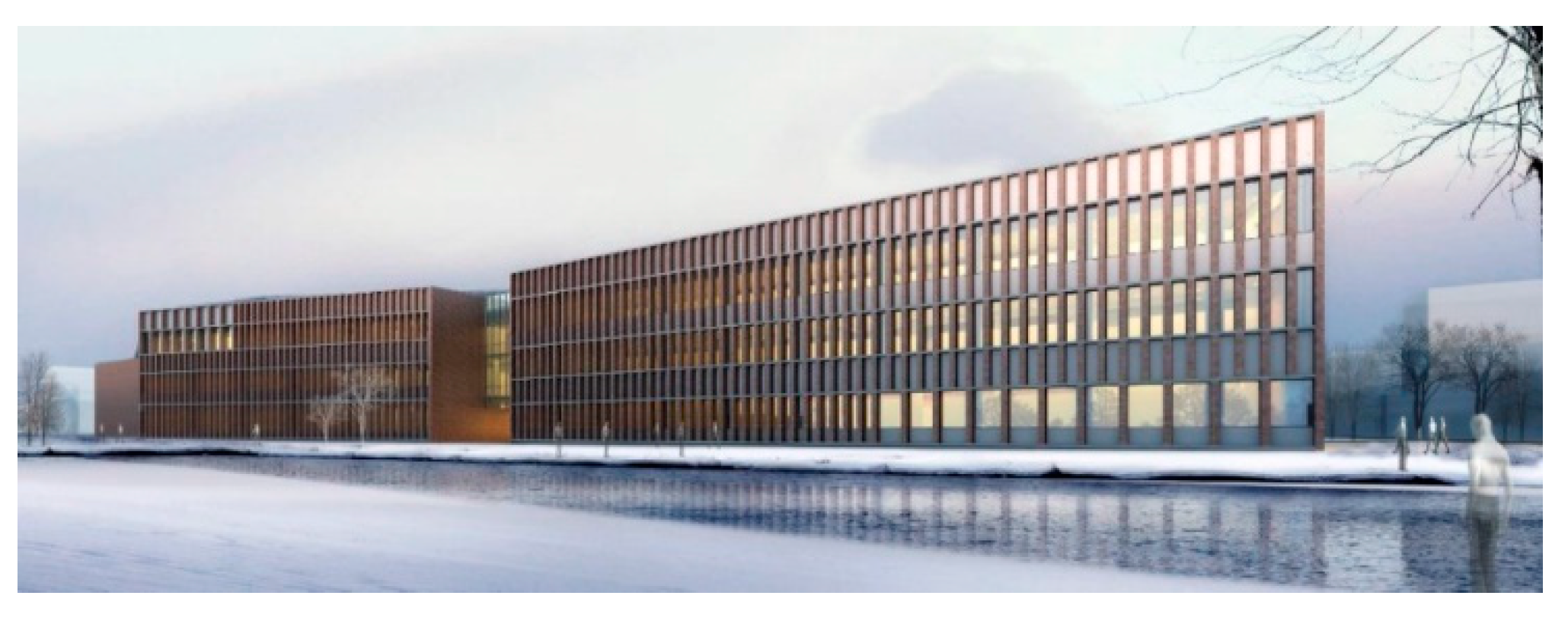

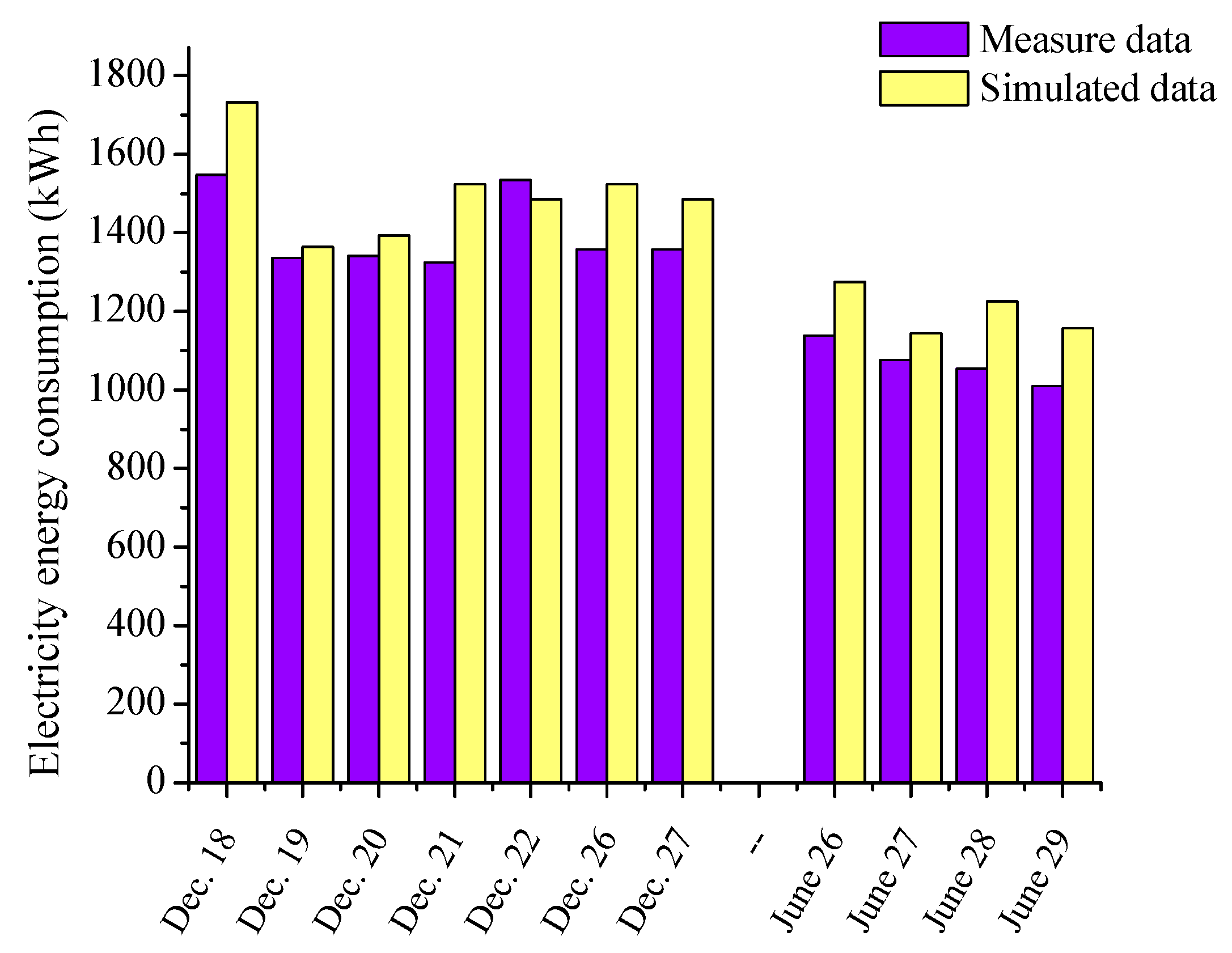

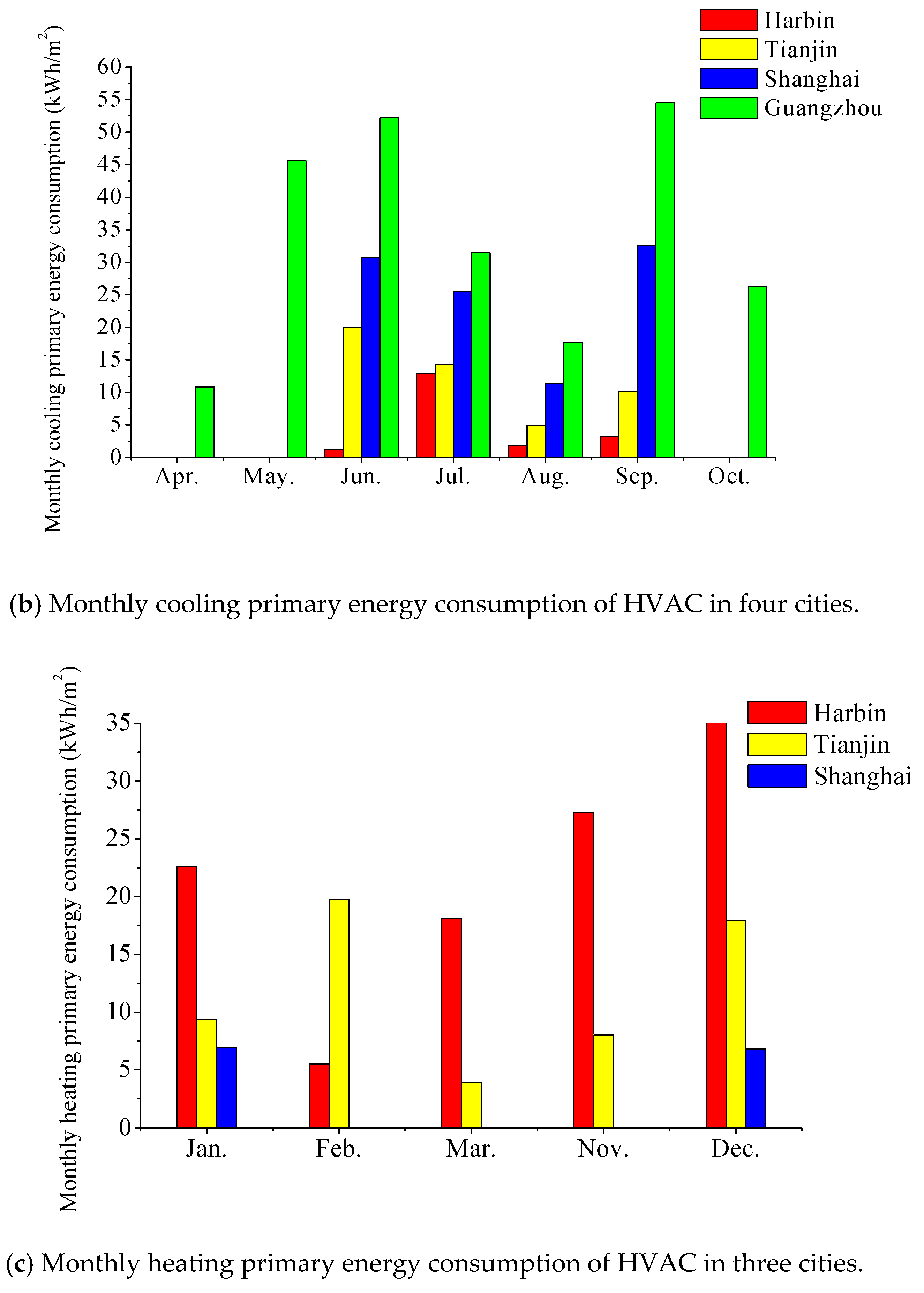

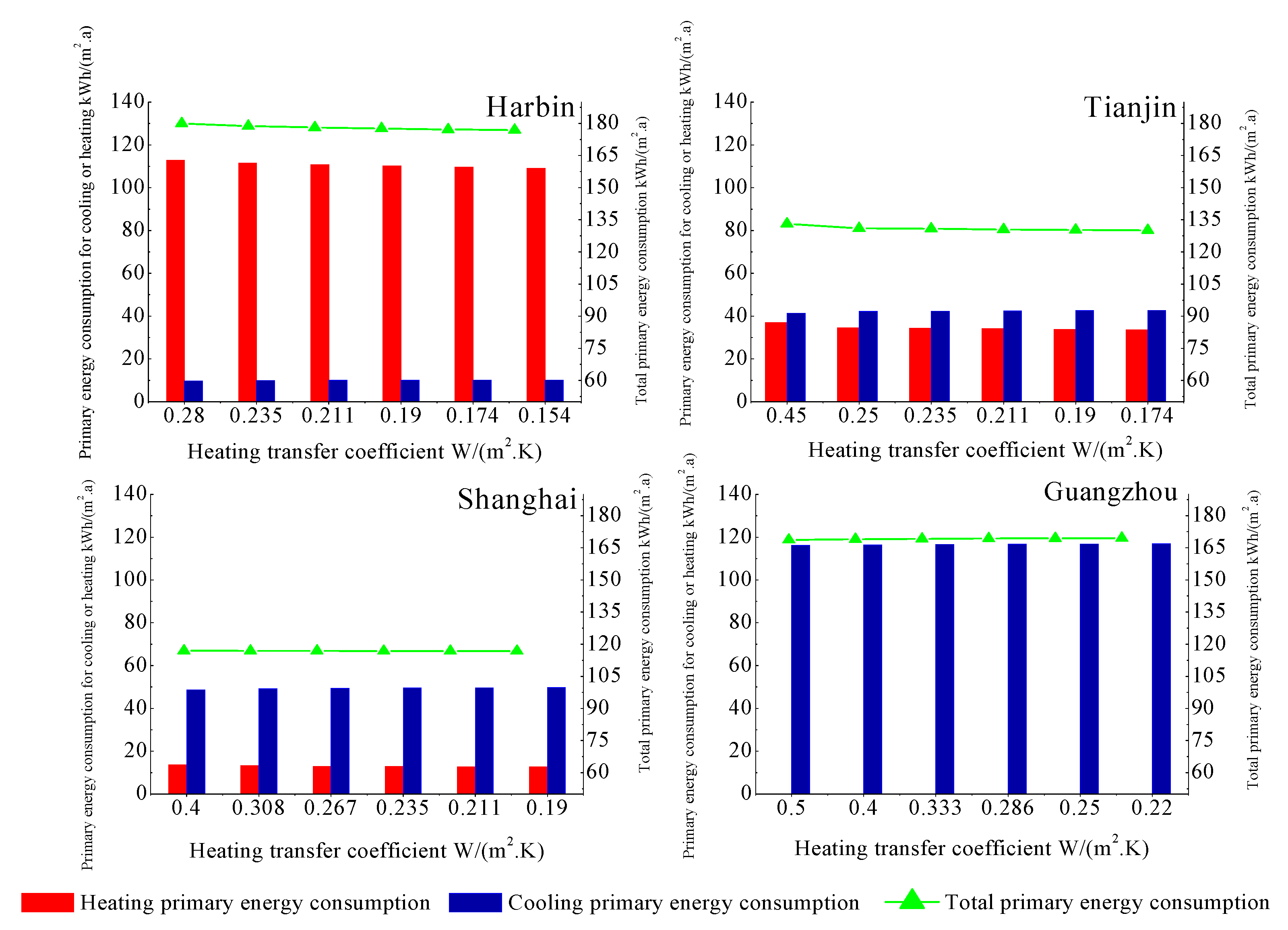
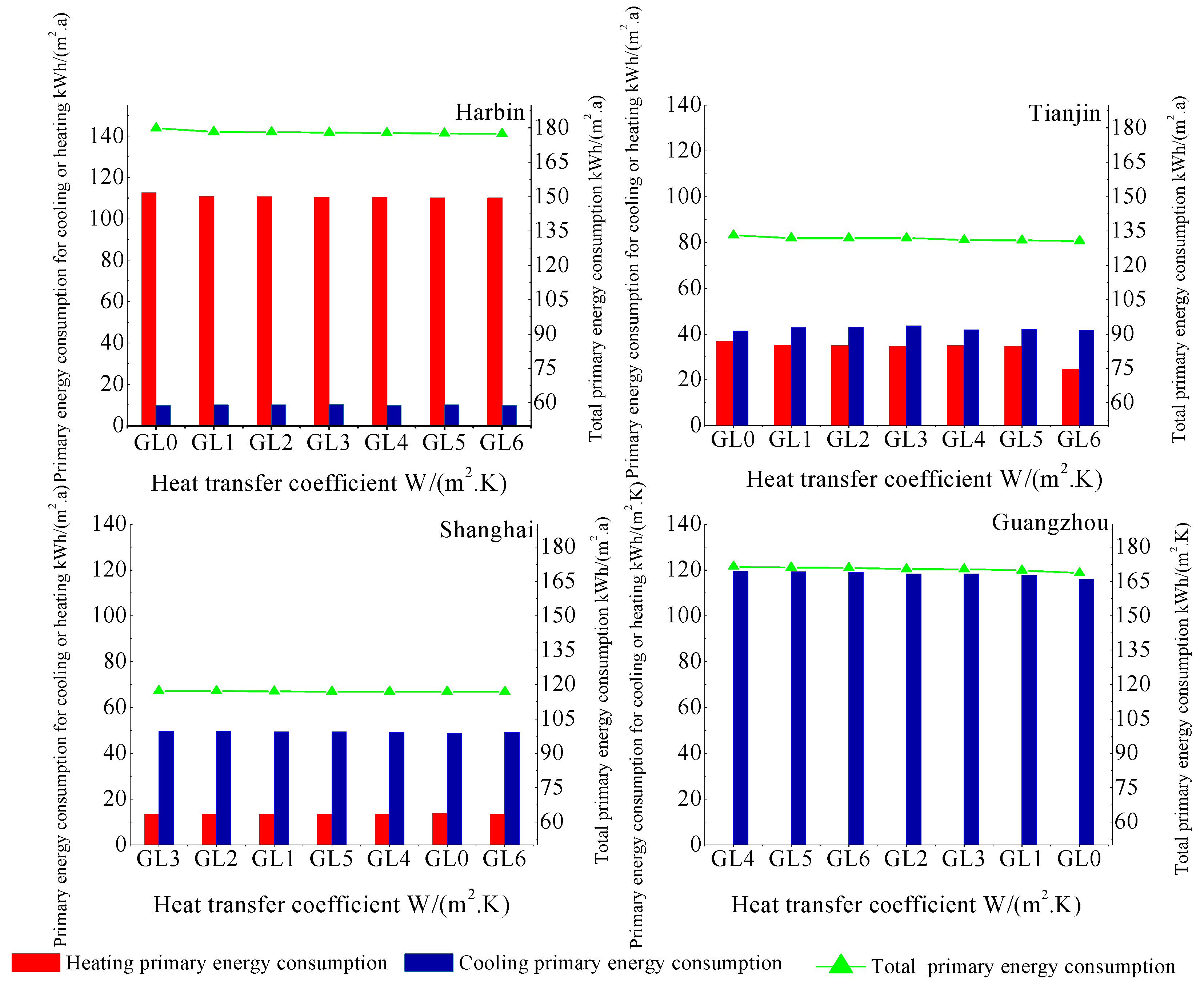
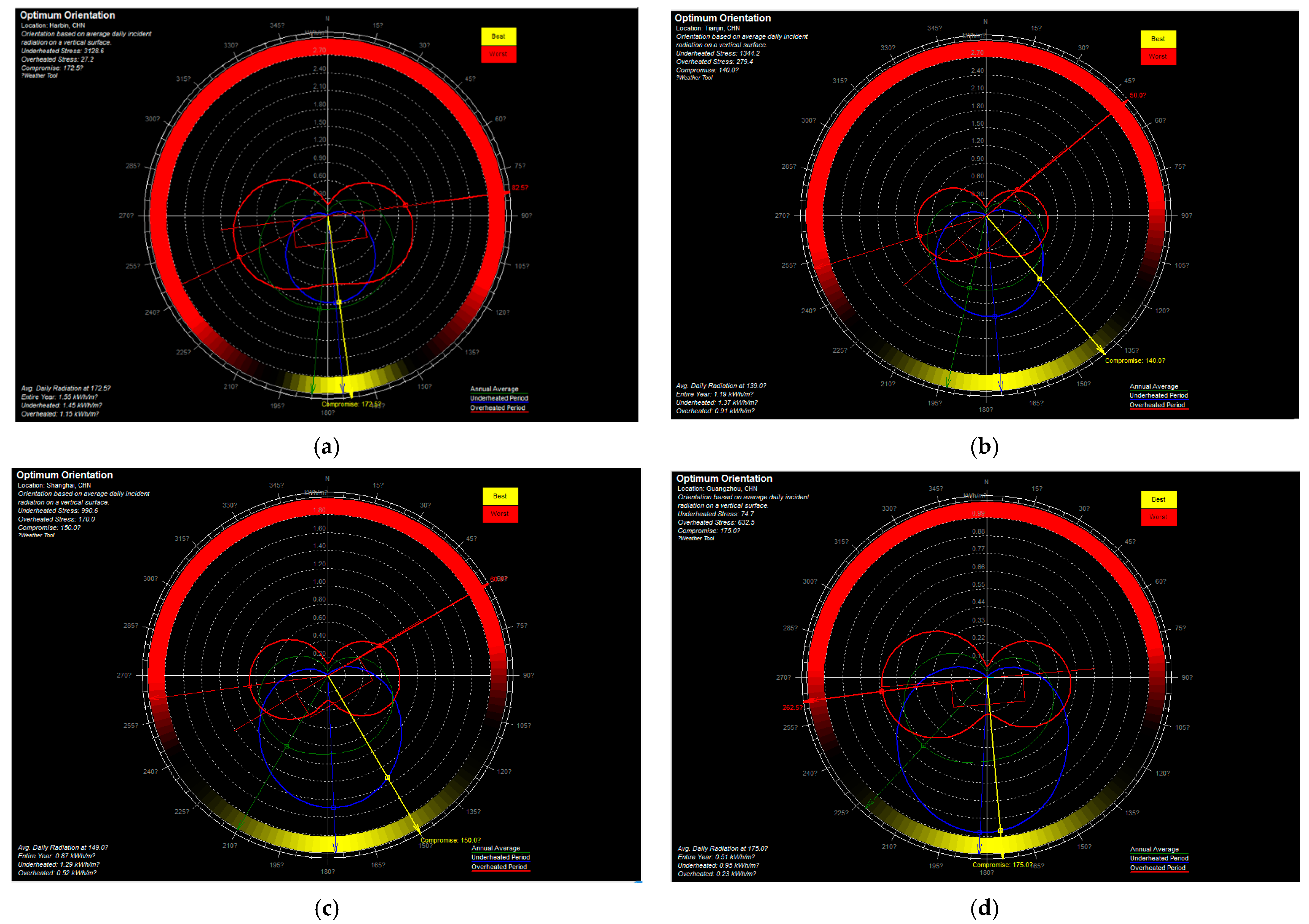


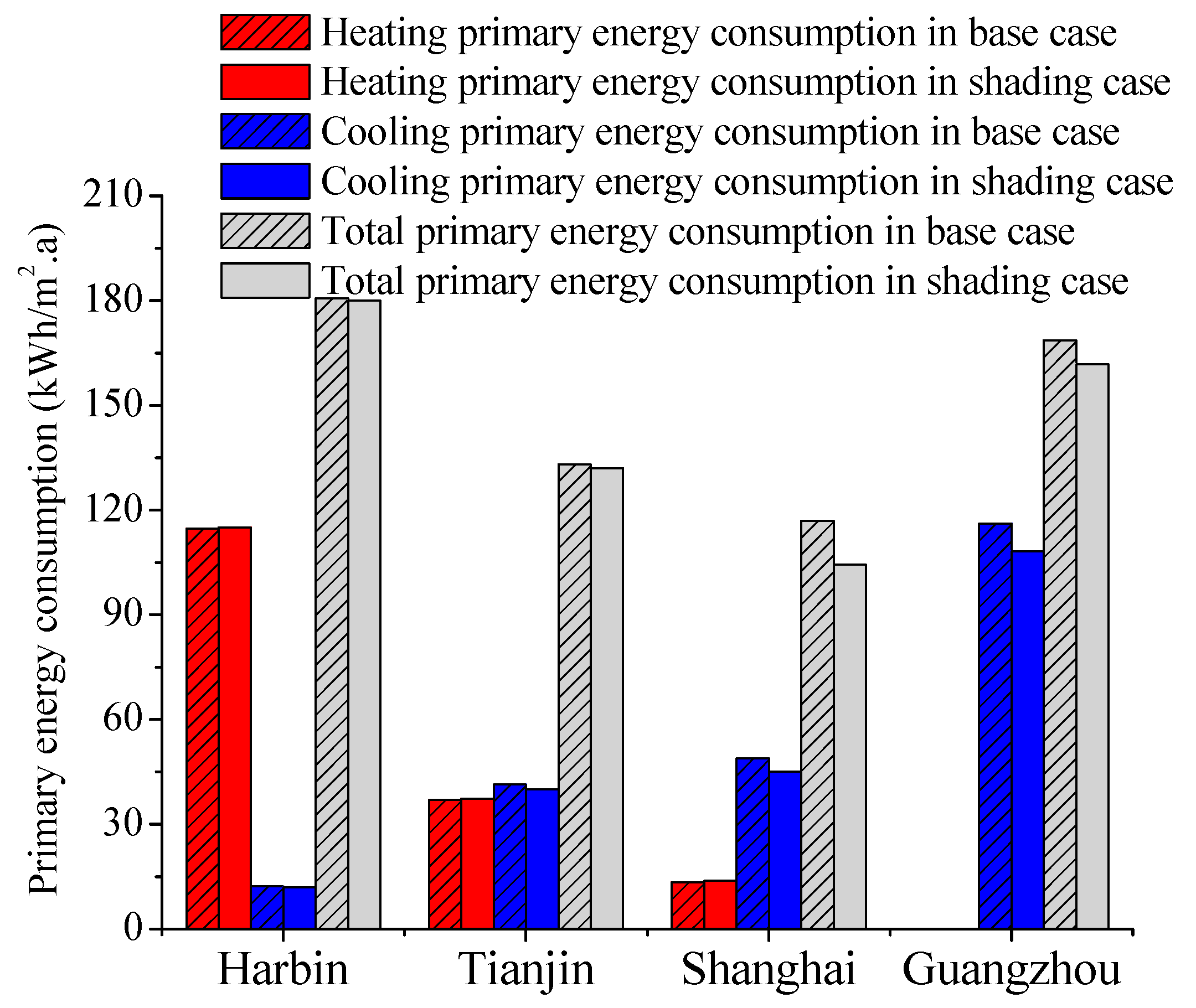

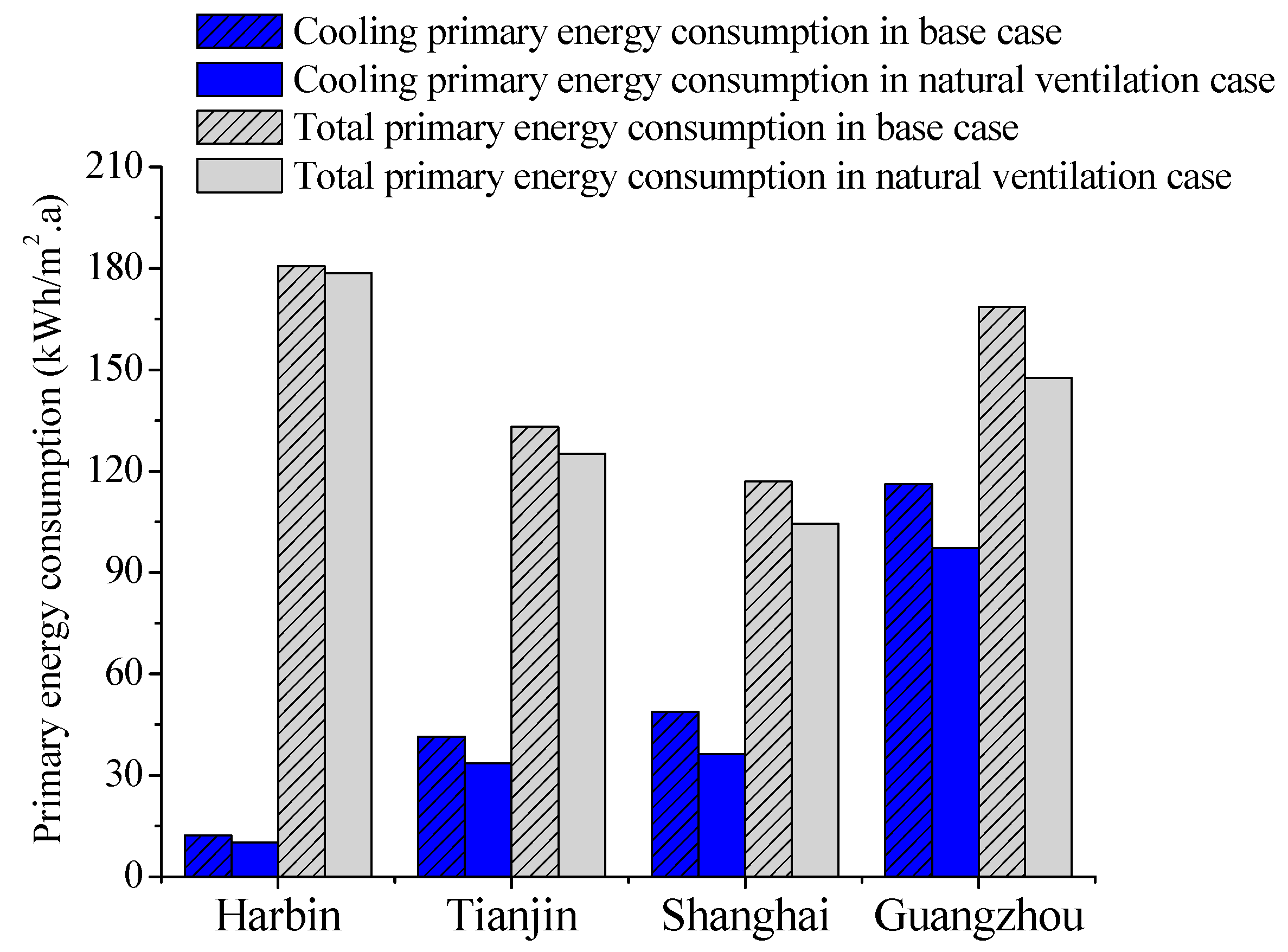
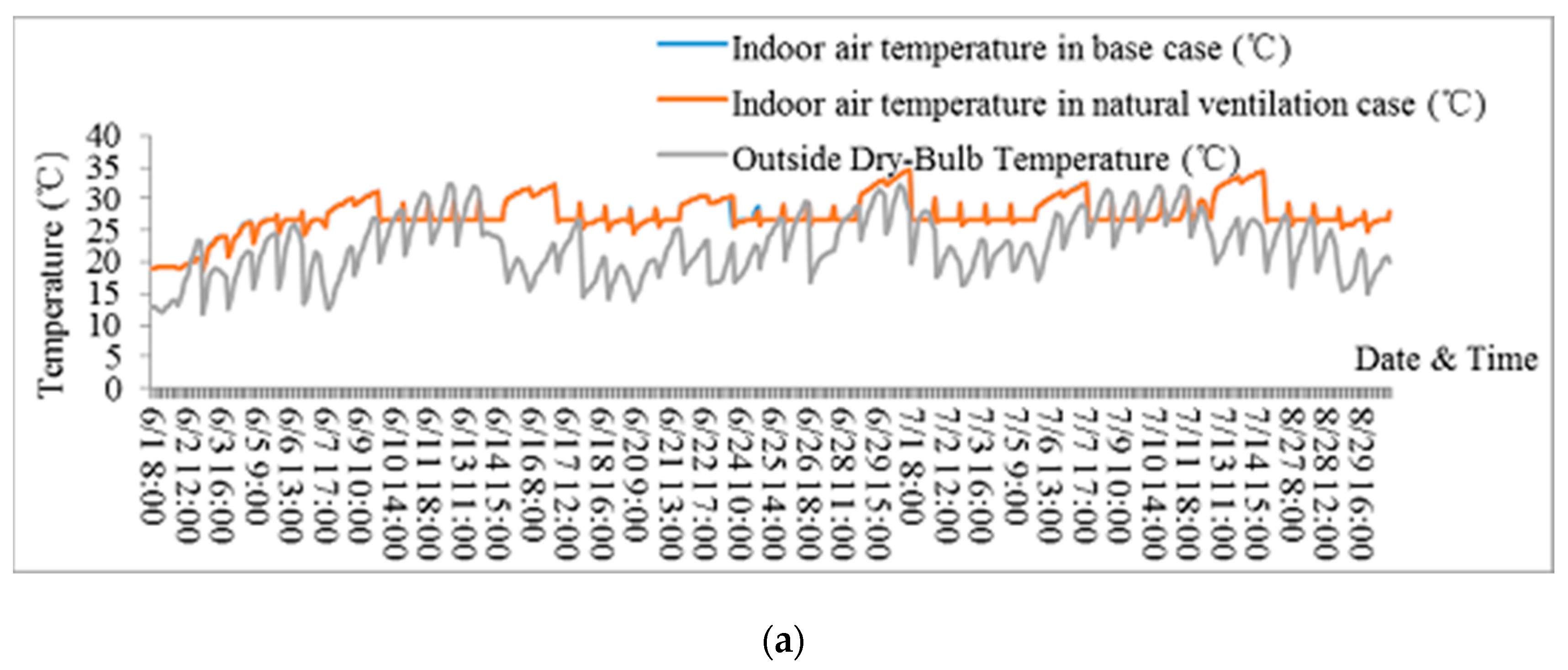
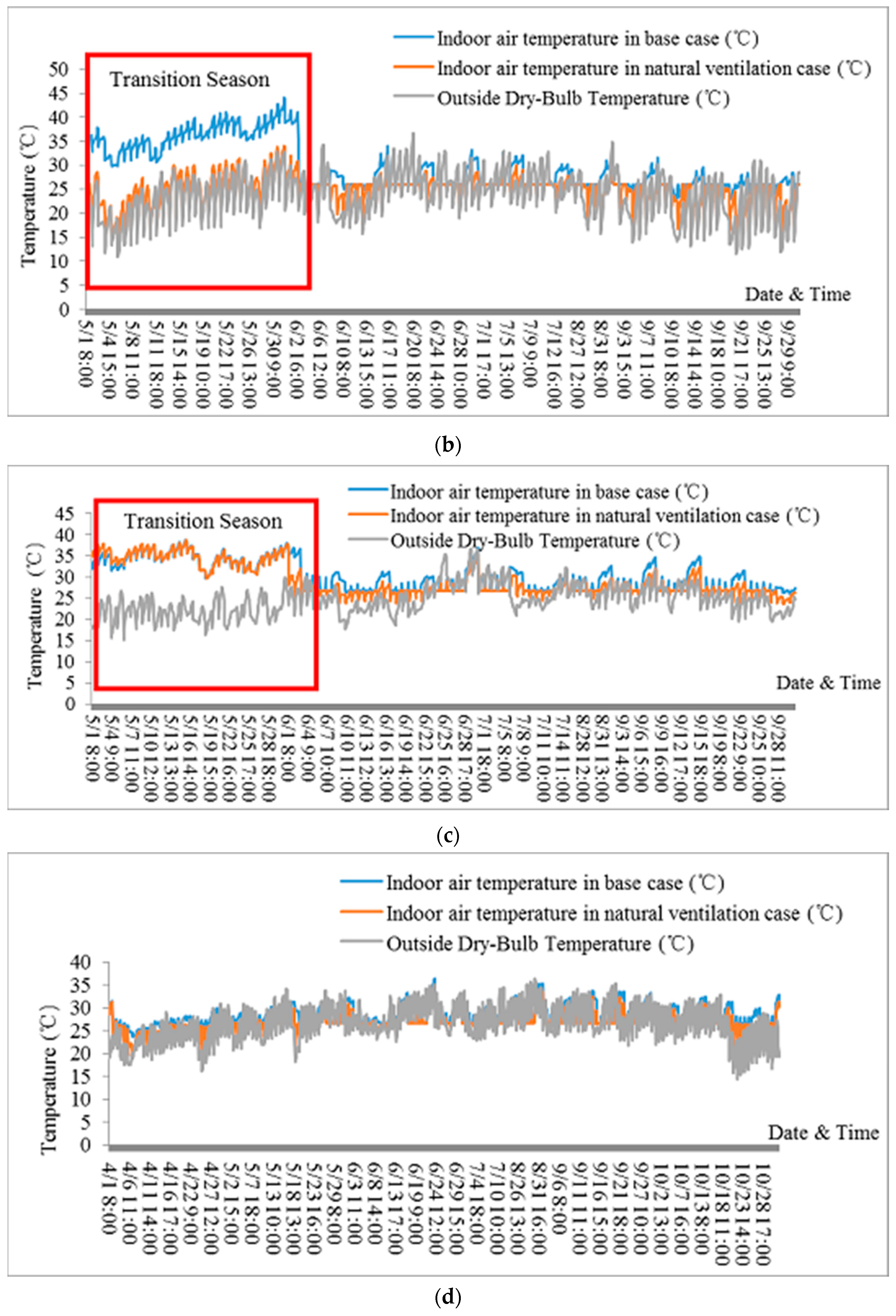
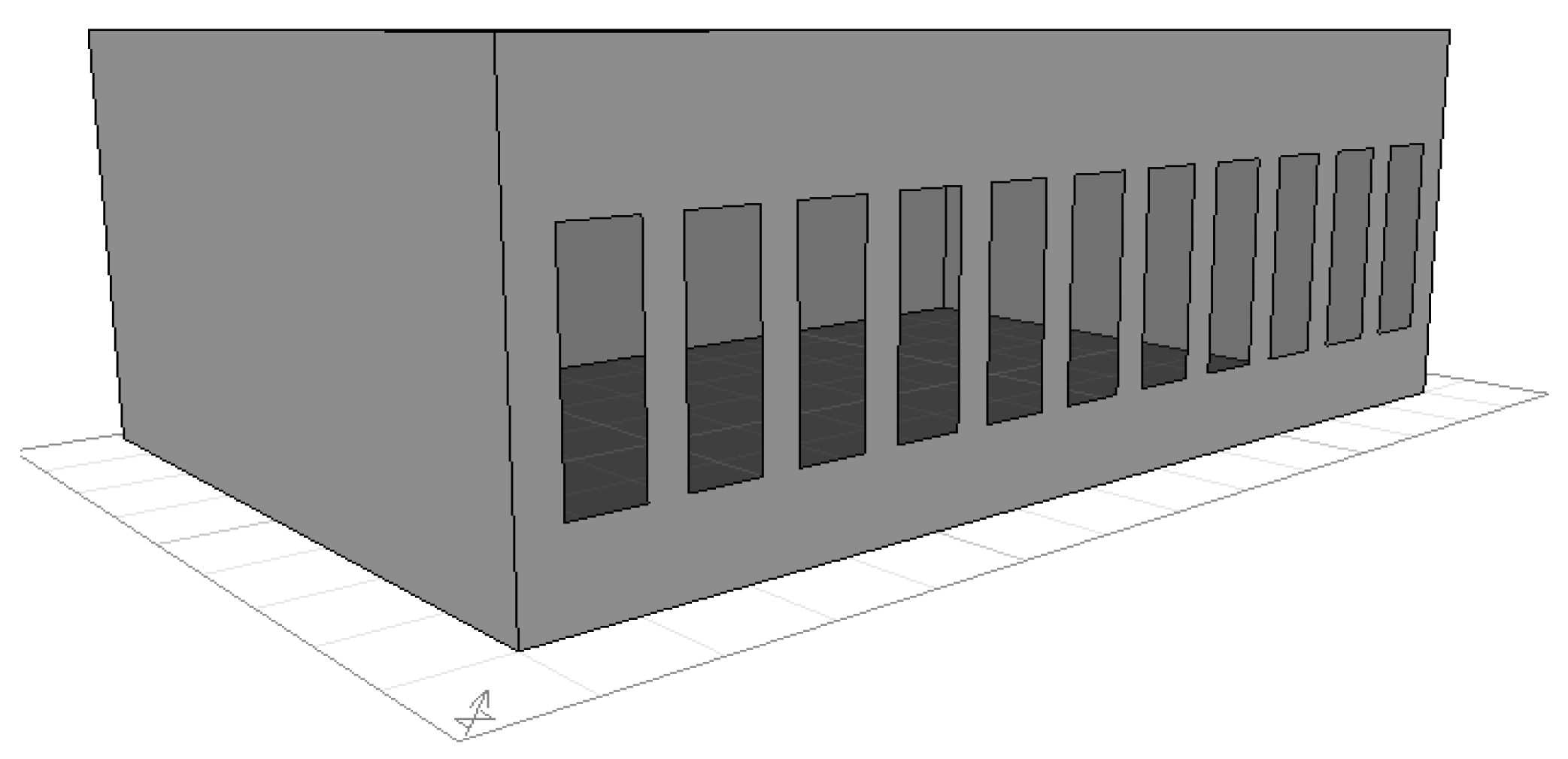
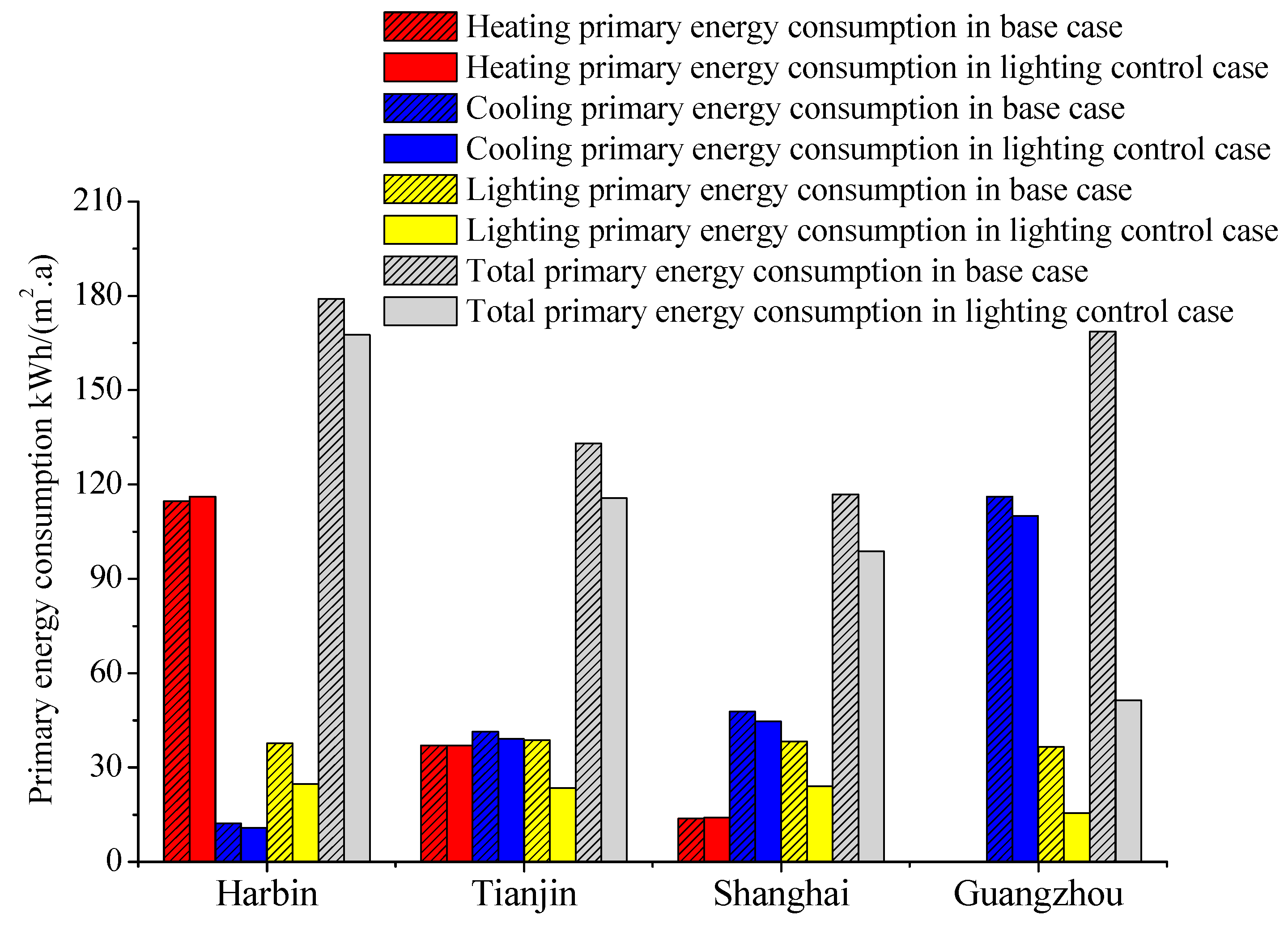
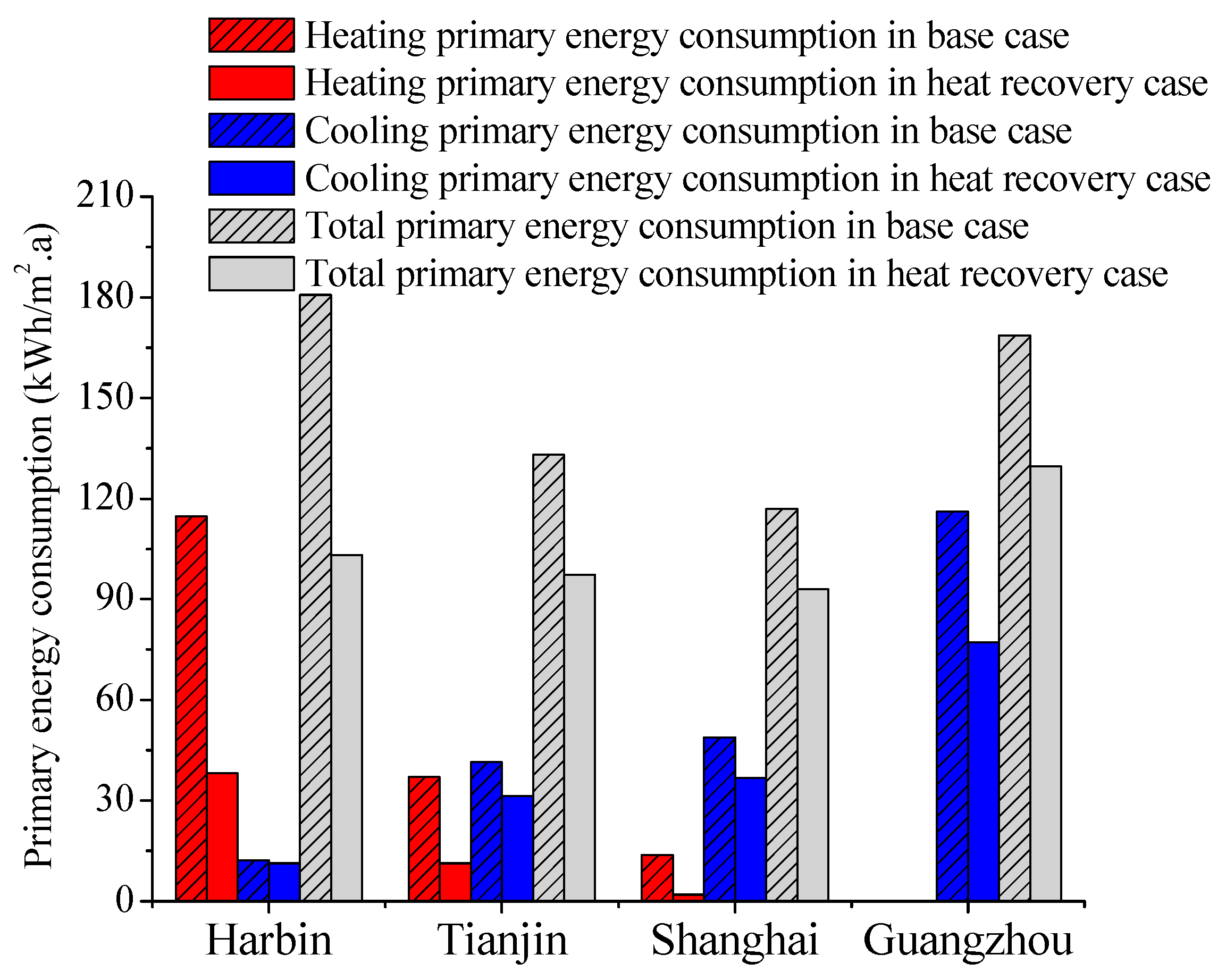


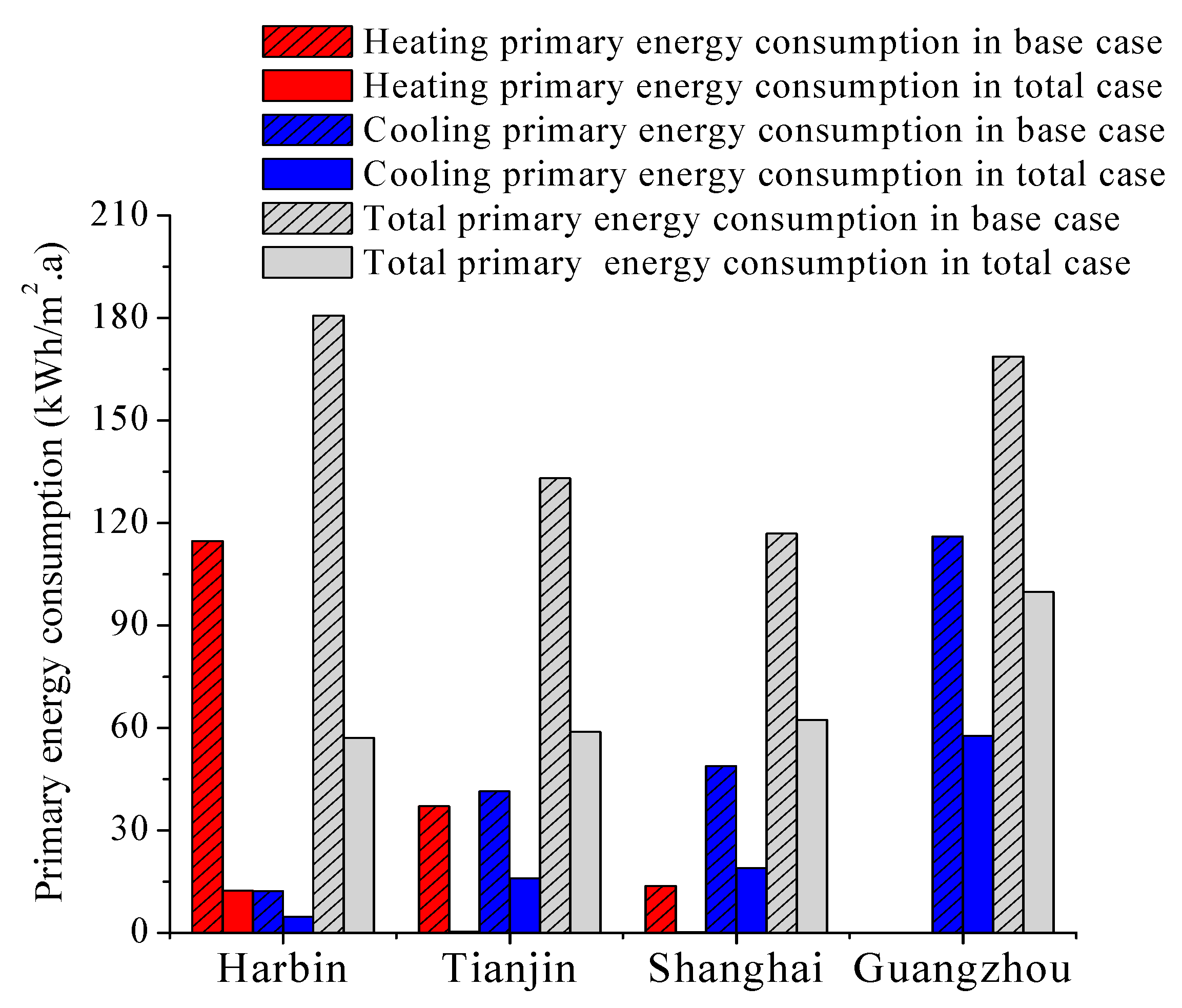
| Climate/Country/City | Reference/Time | Building Type | Energy-Saving Technologies |
|---|---|---|---|
| Mediterranean climate/four cities | [13] (2016) | Residential | Building envelope, phase change materials, cool roof, several window-to-wall ratio (WWR), shading |
| Cold climate | [29] (2005) | Residential | Natural ventilation |
| Mediterranean climate | [38] (2016) | Multipurpose | Earth-to-air heat exchanger |
| Bangladesh | [17] (2017) | Residential | Shading and window glazing |
| Temperate climates | [39] (2016) | Office | Glazing type, WWR, sun shading, and roof strategies |
| Cold Estonian climate | [40] (2014) | Office | Envelope, supply systems, fenestration, and energy sources |
| Mediterranean city | [43] (2017) | Office | Louver shading devices |
| Oslo, Frankfurt, Rome, Athens | [44] (2016) | Office | WWR |
| Subtropical climate | [45] (2010) | Institutional | Variable air volume, high-performance chillers, photo electric dimming control system, double glazed low emittance windows, setpoint temperatures |
| Basque Country | [46] (2017) | Educational | Natural ventilation (summer), loss reduction (winter), solar gain increasing (winter), energy recovery (winter) |
| Hot climatic regions | [47] (2014) | Office | Shading devices |
| The tropical climate | [48] (2018) | Office | Solar shading systems |
| China four climatic regions | [14] (2018) | Office | External walls, roof, window and shading |
| Indoor Temperature in Summer (°C) | Indoor Relative Humidity in Summer (%) | Indoor Temperature in Winter (°C) | Indoor Relative Humidity in Winter (%) | Design Fresh Air Volume (m3/person·h) |
|---|---|---|---|---|
| 26 | 55 | 20 | 35 | 24 |
| Component | Description |
|---|---|
| Exterior wall | 190 mm thick aerated concrete block with 100 mm thick rock wool board |
| Heat transfer coefficient W/(m2·K) | 0.44 |
| Roof | 100 mm thick reinforced concrete floor, 250 mm thick molded polystyrene board |
| Heat transfer coefficient W/(m2·K) | 0.15 |
| Exterior window | Broken bridge aluminum 6 + 12 A + 6 Low-E insulating glass |
| Heat transfer coefficient W/(m2·K) | 2.17 |
| SHGC | 0.53 |
| Interior partition wall | 200 mm thick aerated concrete blocks with double face plastering |
| Heat transfer coefficient W/(m2·K) | 1.50 |
| Room Function | Occupant Density (people/m2) | Lighting Density (W/m2) | Indoor Equipment Power Density (W/m2) |
|---|---|---|---|
| General classroom | 0.7942 | 9 | 5 |
| Ladder classroom | 0.6659 | 9 | 5 |
| Corridor | 0.02 | 5 | 0 |
| Operation time | 7:00–18:00 on weekdays | ||
| Climatic Regions | Index | Representative City | |
|---|---|---|---|
| Leading Index | Auxiliary Index | ||
| SC | Average temperature of the coldest month: ≤−10 °C | The days of daily average temperature ≤5 °C: ≥145 d | Harbin |
| CC | Average temperature of the coldest month: 0 to −10 °C | The days of daily average temperature ≤5 °C: 90–145 d | Tianjin |
| HS/CW | Average temperature of the coldest month: 0–10 °C Average temperature of the hottest month: 25–30 °C | The days of daily average temperature ≤5 °C: 0–90 d The days of daily average temperature ≥25 °C: 40–110 d | Shanghai |
| HS/WW | Average temperature of the coldest month: >10 °C Average temperature of the hottest month: 25–29 °C | The days of daily average temperature ≥25 °C: 100–200 d | Guangzhou |
| MC | Average temperature of the coldest month: 0–13 °C Average temperature of the hottest month: 18–25 °C | The days of daily average temperature ≤5 °C: 0–90 d | Not considered |
| Parameters | Harbin | Tianjin | Shanghai | Guangzhou | |
|---|---|---|---|---|---|
| Indoor design parameters | Winter design temperature (°C) | 20 | 20 | 20 | --- |
| Winter design relative humidity (%) | 35 | 35 | 35 | --- | |
| Summer design temperature (°C) | 26 | 26 | 26 | 26 | |
| Summer design relative humidity (%) | 55 | 55 | 55 | 55 | |
| Design fresh air (m3/person·h) | 24 | 24 | 24 | 24 | |
| Envelope parameters | Exterior wall | 0.38 | 0.50 | 0.60 | 0.80 |
| Heat transfer coefficient W/(m2·K) | |||||
| Roof | 0.28 | 0.45 | 0.40 | 0.50 | |
| Heat transfer coefficient W/(m2·K) | |||||
| Exterior window | |||||
| Heat transfer coefficient W/(m2·K) | 2.20 | 2.40 | 2.60 | 3.00 | |
| SHGC | South 0.48 | South 0.48 | South 0.40/North 0.44 | South 0.35/North 0.44 | |
| Air conditioning parameters | Heating season | Nov. 1–Jan. 15 | Nov. 15–Jan. 15 | Dec. 1–Jan. 15 | --- |
| Feb. 25–Mar. 31 | Feb. 25–Mar. 31 | --- | --- | ||
| Cooling season | Jun. 1–Jul. 15 | Jun. 1–Jul. 15 | Jun. 1–Jul. 15 | Apr. 1–Jul. 15 | |
| Aug. 25–Sep. 30 | Aug. 25–Sep. 30 | Aug. 25–Sep. 30 | Aug. 25–Nov. 1 | ||
| Heating source Heating system efficiency or COP | Gas boiler | Gas Boiler | Air handing unit | --- | |
| 0.9 | 0.9 | --- | --- | ||
| --- | --- | 1.8 | --- | ||
| Cooling source | Chiller | Chiller | Air handing unit | Chiller | |
| Cooling system COP | 4.0 | 4.0 | 2.8 | 2.8 | |
| NO. | Configuration | Heat Transfer Coefficient W/(m2·K) | SHGC |
|---|---|---|---|
| GL1 | 5 Low-E + 9A + 5 + 9A + 5 three layers of insulating glass | 1.461 | 0.380 |
| GL2 | 5 Low-E + 12A + 5 + 12A + 5 three layers of insulating glass | 1.311 | 0.339 |
| GL3 | 5 Low- E + 12Ar + 5 + 12Ar + 5 three-layer argon-filled glass | 1.216 | 0.373 |
| GL4 | 5 Double-silver Low-E + 9Ar + 5 + 9Ar + 5 three-layer argon-filled glass | 1.128 | 0.277 |
| GL5 | 5 Three-silver Low-E + 12Ar + 5 + 12A + 5 three-layer argon-filled glass | 1.023 | 0.267 |
| GL6 | 5 Three-silver Low-E + 12A + 5 three-silver Low-E + 12A + 5 three-layer insulating glass | 0.899 | 0.211 |
| City | Harbin | Tianjin | Shanghai | Guangzhou |
|---|---|---|---|---|
| Transition season | --- | May. 1–May. 30 | May. 1–May. 30 | --- |
| Cooling season | Jun. 1–Jul. 15 | Jun. 1–Jul. 15 | Jun. 1–Jul. 15 | Apr. 1–Jul. 15 |
| Aug. 25–Sep. 30 | Aug. 25–Sep. 30 | Aug. 25–Sep. 30 | Aug. 25–Nov. 1 |
| Typical Days | 8:00 | 9:00 | 10:00 | 11:00 | 12:00 | 13:00 | 14:00 | 15:00 | 16:00 | 17:00 |
|---|---|---|---|---|---|---|---|---|---|---|
| Spring equinox | 33.87 | 7.12 | 1.32 | 0.29 | 0.42 | 2.77 | 13.59 | 37.74 | 62.09 | 97.27 |
| Summer solstice | 2.73 | 0.48 | 0.00 | 0.00 | 0.00 | 0.00 | 1.64 | 16.85 | 36.41 | 52.31 |
| Autumn equinox | 26.29 | 4.23 | 0.88 | 0.41 | 0.82 | 4.26 | 19.58 | 43.71 | 68.28 | 100.00 |
| Winter solstice | 100.00 | 83.10 | 74.91 | 71.42 | 71.42 | 74.91 | 83.10 | 100.00 | 100.00 | 100.00 |
| Typical Days | 8:00 | 9:00 | 10:00 | 11:00 | 12:00 | 13:00 | 14:00 | 15:00 | 16:00 | 17:00 |
|---|---|---|---|---|---|---|---|---|---|---|
| Spring equinox | 22.67 | 2.03 | 0.62 | 1.73 | 8.76 | 26.31 | 37.37 | 47.64 | 60.58 | 80.45 |
| Summer solstice | 15.71 | 9.85 | 26.29 | 46.6 | 62.26 | 66.00 | 61.64 | 57.09 | 58.66 | 67.48 |
| Autumn equinox | 11.69 | 3.71 | 0.08 | 3.75 | 11.41 | 31.70 | 40.38 | 58.61 | 65.11 | 87.56 |
| Winter solstice | 100.00 | 82.89 | 73.34 | 68.83 | 67.04 | 67.58 | 71.03 | 79.60 | 100.00 | 100.00 |
| Typical Days | 8:00 | 9:00 | 10:00 | 11:00 | 12:00 | 13:00 | 14:00 | 15:00 | 16:00 | 17:00 |
|---|---|---|---|---|---|---|---|---|---|---|
| Spring equinox | 17.58 | 2.22 | 1.96 | 6.61 | 24.04 | 31.13 | 36.80 | 44.91 | 57.16 | 80.77 |
| Summer solstice | 0.60 | 0.22 | 0.04 | 0.00 | 0.00 | 2.22 | 9.91 | 21.67 | 36.73 | 52.81 |
| Autumn equinox | 9.02 | 1.96 | 3.30 | 14.48 | 26.90 | 33.45 | 38.43 | 47.29 | 61.51 | 89.11 |
| Winter solstice | 84.50 | 70.74 | 62.58 | 58.80 | 57.28 | 59.60 | 64.52 | 73.12 | 90.97 | 100.00 |
| Typical Days | 8:00 | 9:00 | 10:00 | 11:00 | 12:00 | 13:00 | 14:00 | 15:00 | 16:00 | 17:00 |
|---|---|---|---|---|---|---|---|---|---|---|
| Spring equinox | 55.52 | 31.05 | 21.58 | 28.06 | 37.21 | 38.35 | 33.82 | 30.30 | 38.39 | 57.33 |
| Summer solstice | 40.65 | 24.17 | 10.14 | 3.25 | 0.13 | 0.10 | 4.06 | 12.42 | 27.70 | 45.59 |
| Autumn equinox | 47.93 | 28.73 | 23.40 | 29.95 | 39.25 | 39.17 | 32.91 | 30.07 | 42.02 | 63.02 |
| Winter solstice | 87.11 | 69.94 | 60.52 | 54.96 | 52.23 | 52.62 | 55.56 | 61.72 | 72.26 | 93.82 |
| GSHP | Harbin | Tianjin | Shanghai | Guangzhou |
|---|---|---|---|---|
| SCOP | 6.0 | 6.0 | 2.6 | 2.6 |
| SEER (system energy efficiency ratio) | 5.0 | 5.0 | 3.0 | 3.0 |
| Technology | SC | CC | HS/CW | HS/WW | |
|---|---|---|---|---|---|
| Passive technology | Envelope | 11.3 | 8.9 | 1.8 | --- |
| Shading | 0.4 | 0.8 | 3.2 | 4.1 | |
| Natural ventilation | 1.2 | 5.9 | 10.6 | 12.5 | |
| Active technology | Lighting control | 7.2 | 13.1 | 15.6 | 10.3 |
| Air-to-air heat recovery | 42.9 | 26.9 | 20.4 | 23.1 | |
| Renewable energy | GSHP | 41.2 | 22.4 | 7.3 | 4.6 |
| Technologies | SC Region | CC Region | HS/CW Region | HS/WW Region |
|---|---|---|---|---|
| Exterior walls | 0.129 W/(m2·K) | 0.139 W/(m2·K) | 0.211 W/(m2·K) | 0.800 W/(m2·K) |
| Roof | 0.154 W/(m2·K) | 0.174 W/(m2·K) | 0.211 W/(m2·K) | 0.500 W/(m2·K) |
| Window | GL6 | GL6 | GL6 | Base case |
| Shading | Not recommended | Adjustable louver | Adjustable louver | Adjustable louver |
| Schedule | --- | May to September | May to September | May to October |
| Ventilation | Schedule control strategy | Schedule control strategy | Schedule control strategy | Schedule control strategy |
| Lighting control | Gradual change control | Gradual change control | Gradual change control | Gradual change control |
| Heat recovery | Total heat recovery | Total heat recovery | Total heat recovery | Total heat recovery |
| Efficiency | 75% | 75% | 75% | 75% |
| SCOP of GSHP | 6.0 | 6.0 | 2.6 | 2.6 |
| SEER of GSHP | 5.0 | 5.0 | 3.0 | 3.0 |
© 2019 by the authors. Licensee MDPI, Basel, Switzerland. This article is an open access article distributed under the terms and conditions of the Creative Commons Attribution (CC BY) license (http://creativecommons.org/licenses/by/4.0/).
Share and Cite
Zhao, J.; Du, Y. A Study on Energy-Saving Technologies Optimization towards Nearly Zero Energy Educational Buildings in Four Major Climatic Regions of China. Energies 2019, 12, 4734. https://doi.org/10.3390/en12244734
Zhao J, Du Y. A Study on Energy-Saving Technologies Optimization towards Nearly Zero Energy Educational Buildings in Four Major Climatic Regions of China. Energies. 2019; 12(24):4734. https://doi.org/10.3390/en12244734
Chicago/Turabian StyleZhao, Jing, and Yahui Du. 2019. "A Study on Energy-Saving Technologies Optimization towards Nearly Zero Energy Educational Buildings in Four Major Climatic Regions of China" Energies 12, no. 24: 4734. https://doi.org/10.3390/en12244734
APA StyleZhao, J., & Du, Y. (2019). A Study on Energy-Saving Technologies Optimization towards Nearly Zero Energy Educational Buildings in Four Major Climatic Regions of China. Energies, 12(24), 4734. https://doi.org/10.3390/en12244734






